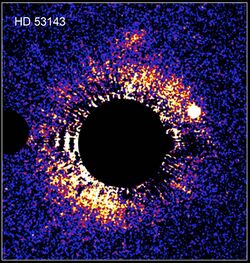Astronomy:HD 53143
 Debris disk around the star HD 53143 by the Hubble Space Telescope. The star itself has been hidden by the camera coronograph to make the disk visible. | |
| Observation data Equinox J2000.0]] (ICRS) | |
|---|---|
| Constellation | Carina[1] |
| Right ascension | 06h 59m 59.65545s[2] |
| Declination | −61° 20′ 10.2546 ″[2] |
| Apparent magnitude (V) | 6.80[3] |
| Characteristics | |
| Spectral type | G9 V[4] |
| U−B color index | +0.43[4] |
| B−V color index | +0.80[4] |
| Astrometry | |
| Radial velocity (Rv) | +21.3[5] km/s |
| Proper motion (μ) | RA: -161.59[2] mas/yr Dec.: +264.67[2] mas/yr |
| Parallax (π) | 54.57 ± 0.34[2] mas |
| Distance | 59.8 ± 0.4 ly (18.3 ± 0.1 pc) |
| Absolute magnitude (MV) | 6.30[6] |
| Details | |
| Radius | 0.85 ± 0.02[7] R☉ |
| Luminosity | 0.7[6] L☉ |
| Temperature | 5,224[6] K |
| Metallicity [Fe/H] | 0.22[8] dex |
| Rotation | 9.6 ± 0.1 days[9] |
| Rotational velocity (v sin i) | 4.0 ± 1.0[7] km/s |
| Age | 1.01 ± 0.13[10] Gyr |
| Other designations | |
Gl 260, CD-61° 1535, HD 53143, LTT 2715, SAO 249700, HIP 33690.[11] | |
| Database references | |
| SIMBAD | data |
HD 53143 is a star in the Carina constellation, located about 59.8 light-years (18.3 parsecs) from the Earth. With an apparent visual magnitude of 6.80, this star is a challenge to view with the naked eye even under ideal viewing conditions.
Using the technique of gyrochronology, which measures the age of a low-mass star based on its rotation, HD 53143 is about 1,010 ± 130 million years old.[10] Depending on the source, the stellar classification for this star is G9 V[4] or K1V,[6] placing it near the borderline between G-type and K-type main sequence stars. In either case, it is generating energy through the thermonuclear fusion of hydrogen at its core. This star is smaller than the Sun, with about 85% of the Sun's radius.[7] It is emitting only 70% of the Sun's luminosity. The effective temperature of the star's outer envelope is cooler than the Sun at 5,224 K, giving it a golden-orange hue.[6]
Debris disk
Based upon an excess of infrared emission, a circumstellar debris disk has been found in this sysyem.[12] This disk is inclined at an angle of about 40–50° to the line of sight from the Earth and it has an estimated mass of more than 7 × 1020 kg. (For comparison, the mass of the Moon is 7.3477 × 1022 kg.) This is one of the oldest known debris disk systems and hence may be replenished through the collision of larger bodies. The observed inner edge of the disk is at a distance of 55 Astronomical Units (AU) from the host star, while it stretches out to twice that distance, or 110 AU. This debris disk may extend outside this range, as the measurements are limited by the sensitivity of the instruments. The dust appears evenly distributed with no indication of clumping.[6] The eccentricity of the ring is also one of the highest known, at 0.21.[9]
References
- ↑ Constellation boundaries, Centre de Données astronomiques de Strasbourg, http://vizier.u-strasbg.fr/vizier/VizieR/constellations.htx, retrieved 2007-07-24
- ↑ 2.0 2.1 2.2 2.3 2.4 van Leeuwen, F. (November 2007), "Validation of the new Hipparcos reduction", Astronomy and Astrophysics 474 (2): 653–664, doi:10.1051/0004-6361:20078357, Bibcode: 2007A&A...474..653V
- ↑ Cousins, A. W. J. (1973), "UBV photometry of some southern stars", Monthly Notes of the Astronomical Society of Southern Africa 32: 11, Bibcode: 1973MNSSA..32...11C
- ↑ 4.0 4.1 4.2 4.3 Torres, C. A. O. et al. (December 2006), "Search for associations containing young stars (SACY). I. Sample and searching method", Astronomy and Astrophysics 460 (3): 695–708, doi:10.1051/0004-6361:20065602, Bibcode: 2006A&A...460..695T
- ↑ Evans, D. S. (June 20–24, 1966). "Determination of Radial Velocities and their Applications, Proceedings from IAU Symposium no. 30". in Alan Henry, Batten; Heard, John Frederick. 30. University of Toronto: International Astronomical Union. pp. 57. Bibcode: 1967IAUS...30...57E.
- ↑ 6.0 6.1 6.2 6.3 6.4 6.5 Kalas, Paul et al. (January 2006), "First Scattered Light Images of Debris Disks around HD 53143 and HD 139664", The Astrophysical Journal 637 (1): L57–L60, doi:10.1086/500305, Bibcode: 2006ApJ...637L..57K
- ↑ 7.0 7.1 7.2 Watson, C. A. et al. (May 2011), "On the alignment of debris discs and their host stars' rotation axis - implications for spin-orbit misalignment in exoplanetary systems", Monthly Notices of the Royal Astronomical Society: Letters 413 (1): L71–L75, doi:10.1111/j.1745-3933.2011.01036.x, Bibcode: 2011MNRAS.413L..71W
- ↑ Árnadóttir, A. S.; Feltzing, S.; Lundström, I. (October 2010), "The ability of intermediate-band Strömgren photometry to correctly identify dwarf, subgiant, and giant stars and provide stellar metallicities and surface gravities", Astronomy and Astrophysics 521: A40, doi:10.1051/0004-6361/200913544, Bibcode: 2010A&A...521A..40A
- ↑ 9.0 9.1 MacGregor, Meredith A.; Hurt, Spencer A.; Stark, Christopher C.; Howard, Ward S.; Weinberger, Alycia J.; Ren, Bin; Schneider, Glenn; Choquet, Elodie et al. (2022). "ALMA Images the Eccentric HD 53143 Debris Disk". The Astrophysical Journal Letters 933 (1): L1. doi:10.3847/2041-8213/ac7729. Bibcode: 2022ApJ...933L...1M.
- ↑ 10.0 10.1 Barnes, Sydney A. (November 2007), "Ages for Illustrative Field Stars Using Gyrochronology: Viability, Limitations, and Errors", The Astrophysical Journal 669 (2): 1167–1189, doi:10.1086/519295, Bibcode: 2007ApJ...669.1167B
- ↑ "NLTT 17321 -- High proper-motion Star", SIMBAD (Centre de Données astronomiques de Strasbourg), http://simbad.u-strasbg.fr/simbad/sim-id?protocol=html&Ident=HD+53143, retrieved 2007-07-24
- ↑ Two new dusty planetary disks may be astrophysical mirrors of our Kuiper Belt, UC Berkeley News, January 19, 2006, http://www.berkeley.edu/news/media/releases/2006/01/19_kuiper.shtml, retrieved 2007-07-24
 |

